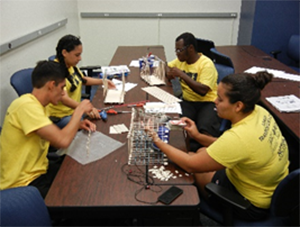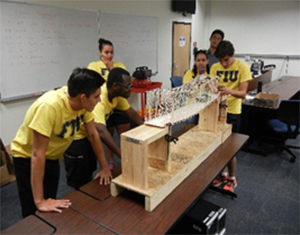InTrans / Jul 01, 2015
ABC activity: Balsa-wood bridges
Go! Magazine
 posted on July 1, 2015
posted on July 1, 2015
When learning about structural engineering, the building of balsa-wood bridges can be a key activity in any engineering class. You can find these scaled bridges made out of balsa wood, lollypop sticks, or even spaghetti (or whatever else is on hand). It is common to use simple weights (such as a few soup cans) to identify how structures behave under stationary loads. With modern, real-world bridge engineering difficulties in mind, this fun activity can get a little more interesting.

How about building a long-span balsa-wood bridge that can withstand both the weight of a moving toy truck and simulated natural disasters? Future prospective bridge engineers in a recent transportation camp for high school students held at Florida International University (FIU) and sponsored by the Accelerated Bridge Construction – University Transportation Center (ABC-UTC) were up to the challenge. The students were tasked to design and build a 3 ft. bridge made up of only 1/16th inch thick balsa wood pieces and glue. If that wasn’t hard enough, the final bridge needed to be fully constructed in less than 30 minutes and then subjected to earthquake-induced displacements, lateral wind forces, and material degradation due to flooding. To make it even more difficult, students had to safely drive a remote control toy truck across the bridge with progressively greater weights.

Imagine the fun in racing a remote control truck across the bridge deck as up to 100 pounds per square inch (psi) of air makes it flutter. But it isn’t all just fun and games. During the design, building, and competition phase of the activity, students learned very important bridge engineering lessons. With respect to engineering mechanics, they learned about different types of bridges, identified development of internal forces in structural members, designed bridge joints and connection details, and considered loadings due to extreme events and material degradation.
On bridge construction, the students had to consider how to prefabricate bridge elements and fully construct their bridge on-site in the 30 minute timeframe. Furthermore, they had to account for all of their materials, which included any waste and extra requested material. Most importantly, the students were introduced to the growing need for Accelerated Bridge Construction (ABC) and its benefits to the public.
As part of the competition, they had to present a skit explaining how and why ABC was necessary. ABC is often used when there is limited construction space and time, bridge durability issues are present, or there is a need for emergency bridge replacement. When asked about their experience, one student responded: “I didn’t even know that Accelerated Bridge Construction existed before the camp. I was amazed you can build an entire bridge off-site and then install it overnight.” The camp and the balsa-wood bridge project proved to be a great learning opportunity and introduction to the many challenges facing bridge engineers today.
You can join in on the fun at home with some of the following end-of-summer challenges:
1. Challenge #1: Build a bridge of your own:
- Choose your materials: Your bridge can be made of anything that you may have laying around the house (e.g., straws, cue tips, toothpicks, lollypop sticks, spaghetti) or you can buy balsa wood from any craft store.
Choose you connection materials: Hot glue is the quickest to set, but Elmer’s glue will also work (with some patience).
Design your bridge: While a truss bridge may be the easiest (and possibly most efficient), don’t let an arch or cable-stayed bridge scare you away. Remember, for ABC, think of how your design can be broken down into parts and then quickly assembled. - Build your bridge: You get to learn here how much care is needed to make sure you build what you originally sketched out.
- Test your bridge: Dust off the back of the pantry cans or let your younger siblings put some of their weight on your bridge to see how much it can hold (or withstand).
- Send in a photo: Let us know what you’re doing at home by sending a photo of your project to babraham@iastate.edu.
2. Challenge #2: Summer research
- Find information online about how much traffic there is on the U.S. Interstate highway system. What kinds of demands are placed on our current bridges? What about our future bridges?
- Identify how natural disasters may affect bridge systems. Consider the I-10 closure in California in July 2015 and the Escambia Bay Bridge in Florida in 2004.
3. Challenge #3: Explore the ABC website and discuss with friends
- Discuss what effect bridge closures may cause for the public and/or private companies.
- Discuss the benefits and challenges that ABC can present.
By Atorod Azizinamini, David Garber, and Kingsley Lau, ABC-UTC, Florida International University